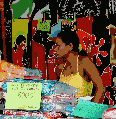|
shore it becomes dangerous in no time at all.
We set off on the 1st of September on the last 250 mile run to Tahiti, our voyage through the Tuamotu Archipelago complete. The wind increased considerably. In the night Michael heard a groan and a screech, looked around and saw the top of the wind vane steering gear was gone! The metal pole had snapped at deck level, the upper part containing the sail, plunging into the sea. Ruefully Michael thought about the expense it would cost us as we were about to arrive in a port considered one of the most expensive in the world!
Tahiti
Maeva Beach, on Tahiti's western side is the place cruising yachts congregate. From there, a half hour ride on a local bus, a converted truck crowded with natives seated on hard wood benches, took us into Papeete. The Immigration officer was uncompromising. Despite the information given us by the French Consulate in NZ, we had to arrange a "bond" at the Bank of Tahiti, as a surety against me pleading poverty and trying to stay forever in French Polynesia.
Tahiti had changed a great deal in the two decades since we had last visited. Gone are the sleepy little villages along the coast divided by long stretches of unkempt verdant countryside. The shores are lined with hotels. The coastal lowlands and even the lower flanks of the steep mountains are covered with fans of development.
Urbanized Tahiti held little romance for us. Claude, a skilled stainless steel fabricator, agreed to fabricate the new windvane for us after studying the template Michael had made from thin plywood. Meanwhile we had met up with Leon and his friend Gambier. With Leon and David, our pearl farming friends up in Tahiti visiting, we wandered through the big covered marketplace, where handsome David, who had lived many years in here, was greeted by vendors young and old with kisses and sparkling eyes.
Papeete is a one product town (if you do not count sarongs!) It is jammed with black pearl shops. "Pearl Tahiti" is the best --- and the priciest. The other shops tumble in it's wake, offering pearls of lesser quality and settings of less genius. Even the humblest market stall gouges the visitor for loose pearls costing more than 30 times those in Gambier! Another Kiwi said, " I had hoped to buy a black pearl here. Just one. But they are phenomenally expensive!" A ring I admired was 750,000 CF, around NZ $ 10,000!
The Pearl Museum founded by Robert Wan, owner of 'Tahiti Perle, and lifelong devotee of the gem was the highlight of Tahiti. It was astonishingly well done. It contained wax figures of Queens, Raj, and Empresses wearing copies of their famous jewels. My favorite was a 17th century pearl trader seated in the cabin of his ship, a panorama of a lagoon and pearl divers out side his window, while he fingered his most beautiful pearl in the dim light. From an iron bound chest at his feet spilled thousands of others, of every possible shape and color, onto the rough deck.
Moorea
When the new windvane was finished we headed out to Moorea, 28 miles away. Moorea was sheer enchantment. Moored in majestic Cook's Bay, the most singularly impressive harbor in Polynesia, along with a handful of other long-distance cruising yachts, we genuinely felt we
|
|













